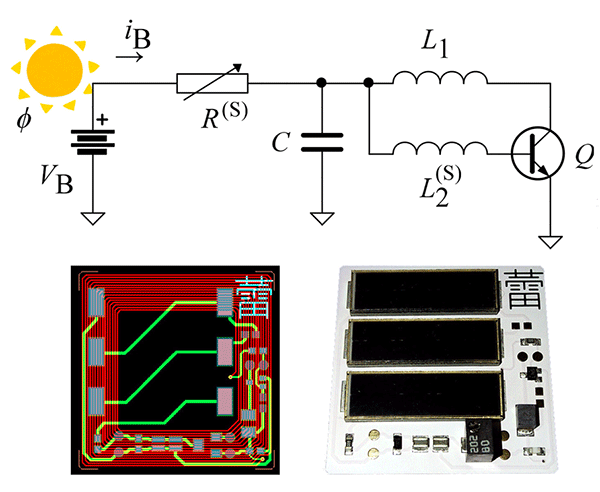Engineers at the Tokyo Institute of Technology (Tokyo Tech) have found a new approach of taking a measurement over an extended area. The technique is based on coupled “chaotic oscillators,” which are highly sensitive electronic circuits that can interact wirelessly through low-frequency low-power electromagnetic coupling. By making each oscillator sensitive to a quantity of interest, such as light intensity, and scattering a number of them sufficiently closely, it is possible to “read out” useful measurement statistics from their collective activity. This technology has many possible applications in biomedical, environmental, and structural monitoring.

Figure 1. Circuit design
Each sensor node consists of a circuit made of just a photovoltaic source, a variable resistor, a capacitor, two inductors and a bipolar transistor (top). One inductor is realized as a printed layer onto the circuit board and used for coupling (bottom, left). The overall design is quite compact, with the majority of the 32 × 32 mm board area taken up by the solar cells. (Image usage restrictions: None, Image credit: Ludovico Minati)
When one thinks of measuring something, the first idea that comes to mind is that of taking a tool, such as a caliper, reaching out to a specific place or thing, and noting down a number. There is no doubt that, in many domains of engineering and science, taking reliable measurements at well-defined locations is fundamentally important. However, this is changing in today’s connected world because we attempt to distribute technology everywhere for improving sustainability. One quickly emerging need is that of efficiently making measurements over relatively large surfaces or objects, for example, comprehensively assessing the soil water content over an entire cultivated plot, checking for cracks throughout the whole volume of a concrete pillar, or sensing tremors across all limb segments in a patient.
In such cases, a measurement taken at a single location is not enough. There is a need to use many sensors, scattered approximately evenly over the area or object of interest, giving rise to a set of techniques termed “distributed sensing.” However, this technique has a potential problem: reading out data from each individual sensor may require considerable infrastructure and power. Especially in situations where only a reliable average or maximum value needs to be computed, it would be preferable if sensors could simply interact between themselves as a population, effectively “coming to an agreement” over the desired statistics, which could then be read out in a way that does not require interrogating each node individually.
However, implementing this electronically is not easy. Digital radio and processing technology is always an option, but is very demanding in terms of size, power, and complexity. An alternative approach is to rely on analog oscillators of a peculiar type, which are very simple but endowed with a remarkable ability to generate complex behaviors, separately and collectively: the so-called “chaotic oscillators.” Now, researchers in Japan and Italy propose a new approach to distributed measurement based on networks of chaotic oscillators [1]. This research was the result of a collaboration between scientists from the Tokyo Institute of Technology, in part funded by the World Research Hub Initiative, the Universities of Catania and Trento, Italy, and the Bruno Kessler Foundation, also in Trento, Italy.
The research team started from the idea, introduced in a previous study [2], that coupling chaotic oscillators, even very weakly as in the case of over-the-air using inductor coils or other antennas, makes it easy for them to create meaningful collective activity. Surprisingly, similar principles seem to arise in networks of neurons, people, or, indeed, electronic oscillators, wherein the activity of their constituents is synchronized. By rendering each oscillator responsive to a particular physical magnitude, such as light intensity, movement, or opening of a crack, it is effectively possible to engender a “collective intelligence” via synchronization, effectively responding to changes that emphasize the sensitivity to an aspect of interest while being robust against perturbations like sensor damage or loss. This is similar to the functioning principles of biological brains.
The key to realizing the proposed circuit was to start from one of the smallest chaotic oscillators known, involving just a single bipolar transistor, two inductors, one capacitor, and one resistor. This circuit, introduced four years ago by Dr. Ludovico Minati, the lead author of the study, and co-workers, was remarkable for its rich behaviors that contrasted with its simplicity







